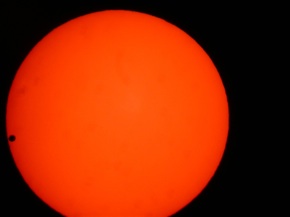Transit of Venus a rare event
On the evening of Tuesday, June 5, the planet Venus will cross the disk of the sun in what astronomers call a “transit.”

The planet Venus is silhouetted by the sun during a “transit” in June 2004. “Transits” are when planets cross the disk of the Sun as observed from Earth. Venus will again transit the sun on June 5, 2012, an event that will not occur again until December 2117. This image was captured by Frederick Kelcz of the University of Wisconsin School of Medicine and Public Health from the athletic fields near UW Hospital and Clinics using a 3.5-inch telescope with a solar filter and a digital camera held up to the telescope’s eyepiece. If viewing or photographing the June 5 transit, it is important to use the right equipment and filters as looking at the sun, especially through a telescope, can result in blindness.
This rare astronomical event is much like a solar eclipse except Venus is too small to darken the sun as the moon would during a solar eclipse. And unless you know the event is happening it would be easy to miss.
The UW–Madison Astronomy Department’s Space Place and Washburn Observatory, however, have planned events that, weather permitting on June 5, will make viewing the transit easy and safe, according to Jim Lattis, Space Place director, who cautions that improper viewing equipment or technique can cause eye damage.
- Space Place will be open from 4:45 p.m. until sunset. The public will be able to view the transit from the rooftop observing deck. There will be a live webcast of the transit in the Space Place lecture hall. UW Space Place is located at 2300 S. Park St. in Madison, in the Atrium of the Villager.
- UW-Madison’s historic Washburn Observatory will be open (weather permitting) from 4:45 p.m. until sunset for viewing the transit with the newly refurbished 15.6-inch refracting telescope.
Transits of Venus are rare events, and this is the second, and last, such transit visible this century.
They occur in pairs, with eight years separating the transits in each pair. The first in the current pair occurred in June 2004; the last one before that was in December 1882. And after this year’s event, the next transit of Venus will not occur until December 2117.
For more information, contact Jim Lattis (608) 263-0360, lattis@astro.wisc.edu.

